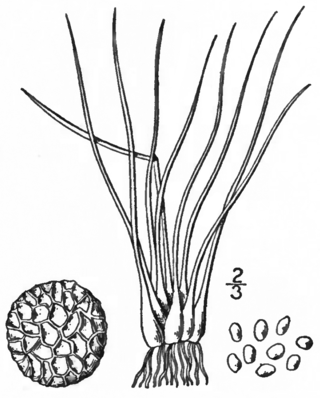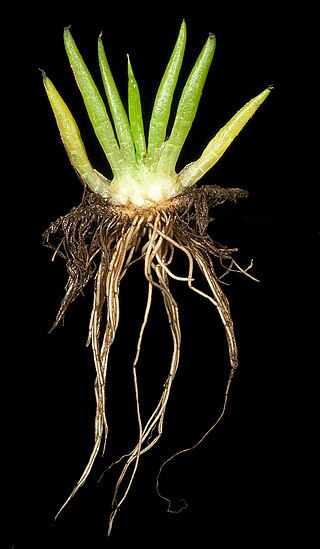
Isoetes, commonly known as the quillworts, is a genus of lycopod. It is the only living genus in the family Isoetaceae and order Isoetales. There are currently 192 recognized species, with a cosmopolitan distribution mostly in aquatic habitats but with the individual species often scarce to rare. Some botanists split the genus, separating two South American species into the genus Stylites, although molecular data place these species among other species of Isoetes, so that Stylites does not warrant taxonomic recognition. Species virtually identical to modern quillworts have existed since the Jurassic epoch, though the timing of the origin of modern Isoetes is subject to considerable uncertainty.

Alexander Carl Heinrich Braun was a German botanist from Regensburg, Bavaria. His research centered on the morphology of plants.

Callitris muelleri is a species of conifer in the family Cupressaceae. It is found only in New South Wales, Australia.

Myristica globosa is a species of plant in the family Myristicaceae. It is found in parts of Melanesia and Australia.

Isoetes engelmannii is a species of aquatic plant in the family Isoetaceae. It is referred to by the common names Engelmann's quillwort or Appalachian quillwort, and is the most widely distributed species of its genus in eastern North America. Its range extends from Ontario in the north, south to Florida and west Arkansas and Missouri. It can be found from April to October in temporary pools, bogs, marshes, stream edges, swamps and along wet roadsides.

Boronia muelleri, commonly known as the forest boronia or pink boronia, is a flowering plant that occurs in forest, woodland and heath in Victoria and New South Wales in Australia. It is an erect, woody shrub or small tree with pinnate leaves and up to fifteen pink to white four-petalled flowers arranged in leaf axils in spring and summer.
Isoetes nuttallii, or Nuttall's quillwort, is a species of quillwort, a type of lycopod. It is native to shallow waters and other wet habitats of western North America from British Columbia to California. It produces up to 60 pointed, cylindrical, green to gray-green leaves, each 7 to 17 centimeters long. The velum completely covers the spherical sporangia, which are 5 millimeters long and 1.5 millimeters wide. The ligule is small and triangular. The megaspores are 400 to 500 micrometers in diameter. The microspores, which are spiny and covered in tubercles, are 28 to 31 micrometers long.

Persoonia gunnii is a species of flowering plant in the family Proteaceae and is endemic to Tasmania. It is an erect shrub with young branchlets that are hairy at first, spatula-shaped to egg-shaped leaves with the narrower end towards the base, and white to cream-coloured flowers.

Persoonia muelleri, commonly known as Mueller’s geebung, is a shrub endemic to Tasmania. It forms a shrub in open areas of wet forests in the west and northeast of the state. It is occasionally confused with P. gunnii though it has larger flowers and longer, straighter leaves.

Calamus muelleri, commonly known as southern lawyer cane or wait-a-while, is a climbing palm with a vine-like habit, endemic to the subtropical coastal rainforests of northern New South Wales and southern Queensland. Sharp hooks on the plant can snag the clothing of walkers in these forests, giving rise to the name "wait-a-while".

Zostera capricorni is a species of eelgrass in the Zosteraceae family. It is native to the seacoasts of New Guinea, Queensland, New South Wales, Victoria, South Australia, Norfolk Island and the North Island of New Zealand. It was first discovered at Moreton Bay in Queensland in 1875.

Zostera muelleri is a southern hemisphere temperate species of seagrass native to the seacoasts of South Australia, Victoria and Tasmania. and New Zealand. Today, Zostera muelleri can be found in regions of Australia, New Zealand, and Papua New Guinea, as well as areas of the eastern Indian Ocean, and the southwest and western central Pacific Ocean. Zostera muelleri is a marine angiosperm, and is commonly referred to as eelgrass or garweed. It is a fast growing and readily colonizing species that serves as a feeding ground for wading birds and aquatic animals, and a breeding ground for juvenile fish and shrimp species.
Najas wrightiana is a species of aquatic plant in the Hydrocharitaceae family. It is referred to by the common name Wright's waternymph, and is found in lakes and streams. It is native to Mexico, Guatemala, Belize, Honduras, the Bahamas, Cuba, and Venezuela. It is also considered introduced and naturalized in southern Florida.

Isoetes riparia, the shore quillwort, is a species of plant in the family Isoetaceae. It can be found in rivers, creeks, and tidal mud flats in southern Quebec and southeastern Ontario, south to eastern New York. It has 5 to 35 long, erect bright green to yellow-green leaves, which are 6 to 35 centimeters long. The velum covers one fourth of the sporangium, which can be 7 millimeters long and 4 millimeters wide. The elongated ligule can grow to be 3 millimeters long. The spherical megaspores are 430 to 680 micrometers in diameter with closely set ridges. The kidney-shaped microspores are 24-35 micrometers long, and usually have spine-tipped tubercules. The megaspores can sometimes come to resemble that of either I. echinospora, if the megaspores become eroded and bear projections that could resemble spines, or I. macrospora, if the broken ridges take a certain shape.

Isoetes tuckermanii, or Tuckerman's quillwort, is a tetraploid species of plant in the family Isoetaceae. It can be found in shallow water in Newfoundland, Nova Scotia, New Brunswick, and south through the New England states to Maryland. It bears 10 to 45 long bright green to yellow green leaves that are 4 to 25 centimeters long, usually erect, but sometimes recurved. The velum covers one fourth or less of the sporangium, which is usually unspotted, 5 millimeters long, and 3 millimeters wide. The white spherical megaspores are 400 to 650 micrometers in diameter, and bear rough-crested ridges that form a hexagonal honeycomb shape. The kidney shaped microspores are 24 to 33 micrometers long, bearing tubercles. It is very similar to I. macrospora, only reliably distinguishable by cytology or through careful megaspore measurement.
Chelmon muelleri, the blackfin coralfish or Muller's coralfish, is a species of marine ray-finned fish, a butterflyfish in the family Chaetodontidae. It is a reef fish which is endemic to Australia.
Isoetes olympica, the Olympic quillwort, is a flowering plant in the family Isoetaceae. The IUCN has classified the species as critically endangered. It was named by Alexander Braun in 1867.

Isoetes australis is quillwort and was first described in 1943 by Samuel Williams.















